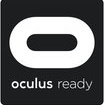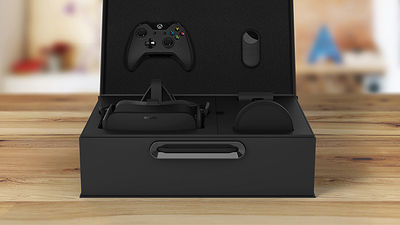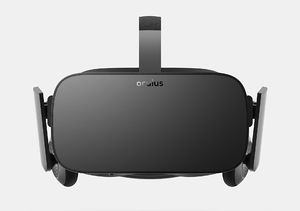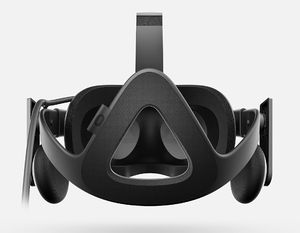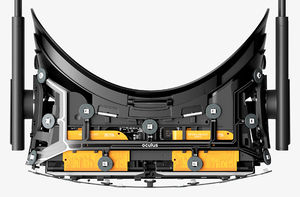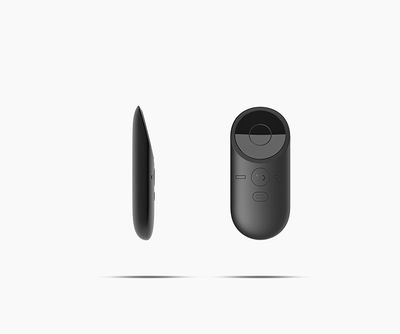Difference between revisions of "Rift"
(→Specifications) |
Xinreality (talk | contribs) (→Recommended) |
||
| Line 59: | Line 59: | ||
==System Requirements== | ==System Requirements== | ||
===Recommended=== | ===Recommended=== | ||
| − | *GPU: NVIDIA GTX 970 or AMD 290, equivalent or greater | + | *'''GPU''': NVIDIA GTX 970 or AMD 290, equivalent or greater |
| − | *CPU: Intel i5-4590, equivalent or greater | + | *'''CPU''': Intel i5-4590, equivalent or greater |
| − | *RAM: 8GB+ | + | *'''RAM''': 8GB+ |
| − | + | *'''OS''': Windows 7 SP1 or newer | |
| − | *Windows 7 SP1 or newer | + | *'''USB Ports''': 3x USB 3.0 ports, 1x USB 2.0 port |
| − | *3x USB 3.0 ports, 1x USB 2.0 port | + | *Compatible HDMI 1.3 video output |
| − | *HDMI 1.3 video output | ||
===Oculus Ready=== | ===Oculus Ready=== | ||
Revision as of 04:20, 23 April 2016
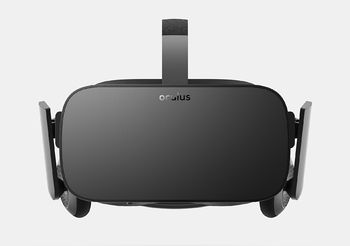
| |
|---|---|
| Developer | Oculus VR |
| Requires | PC |
| Predecessor | Oculus Rift DK2 |
| Successor | Oculus Rift CV2 |
| Operating System | Windows, Mac, Linux |
| Display | Dual 1080 x 1200 OLED Panels |
| Resolution | 2160 x 1200 (1080 x 1200 per eye) |
| Pixel Density | 455.63 PPI per eye |
| Refresh Rate | 90 Hz |
| Persistence | Low |
| Image | |
| Field of View | ?? |
| Optics | |
| Optics | ?? |
| Tracking | 6DOF |
| Rotational Tracking | Gyroscope, Accelerometer, Magnetometer |
| Positional Tracking | External camera sensor |
| Tracking Volume | 100°H x 70°V (over 18 feet range) |
| Latency | Low |
| Audio | Built-in headphones, external headphones, built-in microphone |
| Input | Xbox One controller, Oculus Touch, Oculus Remote |
| Cable Length | 4 meters |
Rift also known as Oculus Rift CV1 or Consumer Version 1 is the 1st version of Oculus Rift Virtual Reality HMD created for consumers. Rift is scheduled to be released in Q1 2016. Unlike its predecessors, DK1 and DK2, Rift's target demographic moves beyond developers and serious VR enthusiasts to include people with only casual interest in VR.
Every order of the Rift comes with the HMD, external camera sensor, Xbox One controller and Oculus Remote. Pre-order of the Rift began on January 6, 2016 for $599. It was officially released on March 28, 2016.
Contents
Hardware
HMD design and Interfaces:
The Rift HMD has a sleek and refined design with improved ergonomics. IPD can be adjusted physically through the slider on the bottom, right side of HMD. Like previous editions, Rift supports eye-relief adjustments, allowing users to increase or decrease the distance between their eyes and lenses. Additionally, Rift will ship ship with multiple facial interfaces with different interior faceplates to accommodate various facial features and users with glasses. The faceplates are interchangeable.
Tracking:
The tracking system employed by Rift is called Constellation. It is an improved version from DK2 and Crescent Bay. While rotational tracking is achieved with IMUs, positional tracking is accomplish with an external camera sensor (outside-in tracking). Tiny LED markers are placed on the HMD, the camera sensor is able to recognize these markers and track the position of the HMD. The markers on the back straps of the HMD allows the back of your head to be tracked, creating a 360 degrees of tracking. Oculus has promised for both seated and standing VR experiences.
External camera sensor:
External camera sensor is not only able to track the headset but also Oculus Touch. Brandon Iribe has mentioned that other hardware manufactures can cover their own devices with the LED markers so they can be tracked too.
Voice and Audio:
Rift will have a microphone and built-in headphones. The built-in headphones can be easily detached and reattached to the HMD. Users can replace the headphones with their own audio devices.
Specifications
Two 90mm HMDs, at a resolution of 1080 x 1200 per eye, makes each display 455.63 PPI[1][2]
System Requirements
Recommended
- GPU: NVIDIA GTX 970 or AMD 290, equivalent or greater
- CPU: Intel i5-4590, equivalent or greater
- RAM: 8GB+
- OS: Windows 7 SP1 or newer
- USB Ports: 3x USB 3.0 ports, 1x USB 2.0 port
- Compatible HDMI 1.3 video output
Oculus Ready
Oculus Ready is a PC program that partners with hardware manufacturers such as Asus, Dell, and Alienware to create pre-built PCs that meet the system requirements of the Rift. PCs that qualify will have an Oculus Ready sticker on its case. Price points of these systems start from under $1000.
Players can purchase Rift bundled with a Oculus Ready PC for $1499.
Compatibility Tool
Check if your Windows PC is Rift ready with the Rift Compatibility Tool. It checks your PC's GPU, RAM, OS, CPU and USB. For each subpar spec, it offers a link to the Compatibility Tool Support Page[3] that recommends necessary upgrades and solutions.
Setup Tutorial
Input Devices
Xbox One controller - comes with every Rift
Oculus Touch - unique controller released after Rift's release
Oculus Remote - allows the user to simply and intuitively navigate VR experiences. It is ideal input device for introducing VR to non-gamers.
Apps
VR Apps from Oculus Share and Oculus Store.
EVE: Valkyrie - comes with every Rift CV1 pre-order.
Lucky's Tale - comes with every Rift CV1.
Developer
Oculus SDK
Unity
Each order of the Rift comes with 4 months of Unity Pro trial.
Tracking volume
- See also: Tracking volume
100°H x 70°V (>18 feet range)
Room size: 15 feet by 15 feet
Images
Rift box set:
HMD:
External camera sensor:
Oculus Remote:
History
January 6, 2016: Pre-orders for the Rift began on Oculus.com for $599.
February 16, 2016: Pre-orders for the Rift and Oculus Ready PC bundle began for $1,499.
References
- ↑ https://www.ifixit.com/Teardown/Oculus+Rift+CV1+Teardown/60612#s126626
- ↑ http://arstechnica.com/gaming/2016/03/ifixit-digs-into-oculus-rifts-461ppi-oled-display-custom-lenses/
- ↑ https://support.oculus.com/hc/en-us/sections/203483987-Compatibility-Tool-and-Error-Messages-
